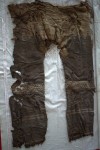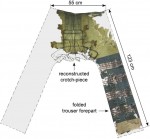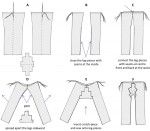 The oldest known trousers in the world have been found in two tombs of the Subeixi culture in northwestern China. The burials are among more than 500 that have been excavated in the Yanghai cemetery near the city of Turfan since the first grave was discovered by local villagers in the 1970s. The cemetery is in a gravel desert, an arid climate that can get as hot as 122°F in the summer and as cold as -20°F in the winter, which ensures the preservation of organic material like human and animal remains, plants and textiles.
The oldest known trousers in the world have been found in two tombs of the Subeixi culture in northwestern China. The burials are among more than 500 that have been excavated in the Yanghai cemetery near the city of Turfan since the first grave was discovered by local villagers in the 1970s. The cemetery is in a gravel desert, an arid climate that can get as hot as 122°F in the summer and as cold as -20°F in the winter, which ensures the preservation of organic material like human and animal remains, plants and textiles.
 The woolen pants were found in tombs M21 and M157. The ones in the former are almost complete, while only fragments of the trousers were found in the latter. Radiocarbon dating analysis on samples of the fabric from both pairs found that the M21 pants date to 1122-926 B.C., while the M157 pants may be slightly older at 1261–1041 B.C. That makes these finds centuries older than the oldest Scythian pants (5th to 3rd centuries B.C.).
The woolen pants were found in tombs M21 and M157. The ones in the former are almost complete, while only fragments of the trousers were found in the latter. Radiocarbon dating analysis on samples of the fabric from both pairs found that the M21 pants date to 1122-926 B.C., while the M157 pants may be slightly older at 1261–1041 B.C. That makes these finds centuries older than the oldest Scythian pants (5th to 3rd centuries B.C.).
This period marked the shift from settled farming and herding communities to nomadic pastoral lifestyles on horseback in central Asia. The bit and harness made controlling the horse at high speeds over long distances or during battle possible, but now the riders needed an article of clothing that would allow them to side astride while protecting their legs and genitals. The tunics, gowns, and the combination of loincloth and individual leggings tied to a waistband like Otzi the Iceman was wearing 2,000 years earlier when he died in the Alps weren’t going to do the trick.
It was the invention of the crotch that ushered in the era of the trousers. The crotch joins the legs together with the abdominal section and waist, converting the four pieces of the leggings-waistband-loincloth rig into a single garment. This design allowed riders to spread their legs as wide as they needed to while still protecting the inginual and pelvic areas.
 The Yanghai trousers, particularly the pair found in tomb M21, illuminate this revolutionary construction. Even the damage is helpful to archaeologists. The front of the trousers and the left leg are in excellent condition, while the back and right leg have holes that fortuitously expose the inside of the pants and the left seams. A new study published in Quaternary International found that the trousers are formed from three separately woven pieces: two straight-cut legs and a stepped cross-shaped crotch that covers the genitals from the front to the back. There are side slits in the waistband, and a remnant of string at the edges of the slits suggests the trousers were closed on both sides with drawstrings.
The Yanghai trousers, particularly the pair found in tomb M21, illuminate this revolutionary construction. Even the damage is helpful to archaeologists. The front of the trousers and the left leg are in excellent condition, while the back and right leg have holes that fortuitously expose the inside of the pants and the left seams. A new study published in Quaternary International found that the trousers are formed from three separately woven pieces: two straight-cut legs and a stepped cross-shaped crotch that covers the genitals from the front to the back. There are side slits in the waistband, and a remnant of string at the edges of the slits suggests the trousers were closed on both sides with drawstrings.
The seams on the inside of the legs and the edges where the crotch-piece is stitched to the legs are covered with a decorative braid. There’s also decoration woven into the fabric.
The warp thread in the leg-pieces is brown but cream-coloured in the crotch-piece, whereas the weft changes between brown and cream and so forms patterns. At the upper part of the trousers, where the fabric covers the abdomen, the ground colour is cream and the ornaments are brown weft. Double lines of brown weft were woven into the fabric decorating the entire crotch-piece at regular intervals. By contrast, the fabric of the leg-pieces is dominated by a shade of brown, on which the ornaments stick out in cream-shaded weft. At the height of the crotch the background colour changes from shades of cream to brown through an interlocking stepped triangle pattern. At the height of the knees a zone of rhombic meandering ornament occurs. At the height of the calves two parallel zigzag lines and a third one just above the hemline are woven around the leg.
 No cloth was cut in the making of these pants. Each piece was woven individually to fit the person who wore them. Since the yarns and threads all match, either one person did all the work or the weaver and tailor worked closely together.
No cloth was cut in the making of these pants. Each piece was woven individually to fit the person who wore them. Since the yarns and threads all match, either one person did all the work or the weaver and tailor worked closely together.
Horse-related grave goods found in both tombs underscore the connection between the trousers and their function. The man buried in M21 went to his eternal rest with a decorated leather bridle with a wooden horse bit hanging from a stick near his head. Tomb M157 includes a whip, a decorated horse tail, a bow sheath and a bow. Both men were about 40 years old at the time of death and were buried wearing the ancestors of riding breeches.
Do these pairs of trousers look ‘stone-washed’, or what ? What kind of material was used here ? Moreover, the sequence of tailoring pretty much seems to be in line with the sequence of historical development. As mainly riders need additional protection of essential parts, and riders do know that the protection needs to be the right one, who was actually buried in tombs M21 and M157 ? Were they peasants or kings ? Were they possibly asian traders, warriors or herdsmen on horses ? Furthermore, I read elsewhere that the Subeixi culture came up with Scythian-style bows. Does that mean that the scyth trousers were in fact ‘Subeixi-style’, or was there -once more- western scyth copyright blatantly violated ?
Did the article mention the ethnicity of the human remains? Turfan is located in the autonomous region of Uighur, near the Taklimakan Desert. Caucasian riders from Central Asia entered this region about 3,000 B.C. bringing with them the bit and bridle, domesticated horses, the wheel and bronze weaponry. Also found in the tombs were tartan plaid clothing that had been preserved exceptionally well due to the arid climate, with garments retaining their brilliant dyed hues. Dr. Victor Mair and colleagues were able to study the Taklimakan Desert caucasian mummies displayed in the local museum for a brief period in 1995.
I meant to say, 3,000 years ago. Sorry for the error.
My thought too, Emily: is the description of the upper part of the trousers a way of saying that that part is tartan?
The trousers were woven as individually shaped pattern pieces? How cool. The pattern and the technique reminds me of weaving done in the Yucatan on narrow looms weighted with sticks. Whole ponchos/shirts, including the neckline and shoulder curves, are woven in one piece and embellished flat, then sewn together at the seams. These weaver/tailors probably made the entire piece from scratch. The pattern pieces are fairly simple and would be easy to map out as a template in a non mechanical, custom loom. It seems like the way to design clothes if you haven’t got tailoring scissors!
I guess I meant to say that I think the person who made these pants probably created the whole design- there was no separation of labor between weaving and sewing.
The pictures do not seem to clearly show a tartan plaid, only longitudinal warp threads. http://www.independent.co.uk/news/world/asia/a-meeting-of-civilisations-the-mystery-of-chinas-celtic-mummies-413638.html is one article that mentions the tartans and the origin of the mummies, Celtic nomads, at last confirmed by dna analysis. The Mummies of Urumchi, written by textile expert Elizabeth Wayland Barber is heavily illustrated with photographs of the mummies in their tartan wrappings, which are very primitive patterns. As clans intermarried, just like a coat of arms, the tartans became more elaborate and complex.
“mentions the tartans and the origin of the mummies, Celtic nomads”: that’s what I was hoping for, an entertaining burst of Celtomania, occurring just when the idea of Celtism in Western Europe, and particularly the British Isles, seems to be in decline among historians.
:notworthy: :notworthy: :notworthy: :notworthy: :notworthy: :notworthy: :notworthy: :notworthy: :notworthy:
As Emily mentioned, “tartan” simply refers to a weaving motif identified with a particular clan or group, not a specific design. Tartans could even be plain or stripes, inserted warps, a twill weave (some of the patterns in the pants above are suggestive of a simple 3 warp twill). These kinds of weaves and patterns developed in various places in the world independently of one another, and were often used simply as ornament (as I suspect in the case of these pants). The use of pieces woven to be sewn together is standard in weaving and a very practical way of creating complex woven garments. It is still used today, even to create couturier clothing. FWIW: your jeans are woven in a straight twill pattern identical in structure to many ancient fabrics. Twill not only lends itself to many patterns, it is flexible and comfortable.
I am interested in the pant dimensions and am also curious about the men who wore them, but this piece was about construction, and one can only cover so much in a single short essay. Every time there is a find of an ancient piece of clothing or textile, weavers and spinners sit up and take notice. Now I shall spend some time looking up answers to as many of my questions as it is possible to answer right now. Thanks, Livius.
Emily, the article you link to unfortunately contains a lot of conjecture based on assumptions about Celtic culture. The fact is that people have never been discreet genetic or ethnic groups. Even in Africa, people migrated to and fro, mixed, shared cultural elements, and have been doing so since leaving Africa. In America, after only a few hundred years, so much mixing has occurred that dna cannot separate some Native American groups from their surrounding European derived neighbors. It is likely that all of us share both dna and cultural elements from various groups that encountered each other in various migrations over the millenia, no matter what ethnic group we are currently identified with. There are places in Asia, Siberia, and India where dna supposedly limited to European Jews is found, as well as some cultural practices. The people look like others in their locale. A few days ago, I met a woman about my size and build on the train. Our facial features were strikingly similar. She was brown, with long (gorgeous) dreadlocks. I am fair, with classic Scandinavian coloring: wavy light red hair, blue eyes (and an African build, as my great-great grandmother was African). We joined each other at lunch, and as we talked, learned that we have Navajo ancestry in common. We both at times (independently, as we had not met before) visit the reservation and have a similar experience: the folks there look at us and recognize us as one of theirs, treating us accordingly. Our dna does not recognize that we are native american, but the culture does. I guess what I am saying here is that we need to be careful about taking assumptions based on expectation as evidence. As the history of science itself shows, it is too easy to go off track that way. Science is by its nature self-correcting and will eventually find its way out of the various cul-de-sacs it finds itself in. Cultural assumptions are less accommodating in adapting to changes in evidence.
“Does that mean that the scyth trousers were in fact ‘Subeixi-style’, or was there -once more- western scyth copyright blatantly violated ?”
You must be trolling.